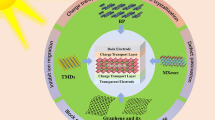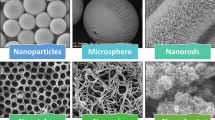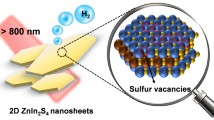Abstract
Environment friendly third-generation solar cells sensitized by dyes, quantum dots, and perovskites are seen as promising energy alternatives. Among the various strategies, employing one-dimensional nanostructures that exemplify the smallest dimension for efficient carrier transport rate from the active layer to electron transport layer (ETL) in photovoltaic devices is attempted in this work. We herein report the synthesis of well-aligned 1-D TiO2 nanocones as ETL for photovoltaic thin films by varying the precursor concentration (0.03 M, 0.04 M, 0.05 M) to track the evolution of growth. The hydrothermal approach is exploited to grow oriented rutile TiO2 nanocones on fluorine doped tin oxide (FTO) under neutral conditions. The examination of phase, crystallinity, morphology, and opto-electronic properties of the well-structured nanocone arrays is characterized by X-ray diffraction (XRD), scanning electron microscopy (SEM), energy dispersive X-ray spectroscopy (EDX), ultra violet diffuse reflectance spectroscopy (UV-DRS), Brunnauer–Emmett–Teller (BET) surface area analysis, and field-dependent dark and photoconductivity analysis. The XRD pattern confirms the formation of the tetragonal rutile phase. SEM micrographs and UV-DRS spectroscopy reveals that the length of the nanocones and the energy gap is found to be maximum for 0.04 M concentration with a well-defined excitation band at 316 nm. Significantly, a strong light-trapping effect that decreases the incident light reflections and correspondingly increases the light absorption is unveiled through photoconductive studies for the TiO2 nanocones at 0.04 M having a surface area of 81.767 m2/g. The investigation essentially suggests that the as-prepared one-dimensional nanostructures would serve as efficient photoanodes in environment safe third-generation solar cells.






Similar content being viewed by others
Data availability
The datasets used and/or analyzed during the current study are available from the corresponding author on reasonable request.
References
Abdelraheem AH, El-Shazly A, Elkady M (2019) Comparable investigation of polyaniline behavior towards gaseous ammonia and toluene adsorption. Environ Sci Pollut Res 26(4):3991–3999. https://doi.org/10.1007/s11356-018-3877-y
Alberti A, Smecca E, Valastro S, Deretzis I, Mannino G, Bongiorno C, La Magna A (2022) Perovskite solar cells from the viewpoint of innovation and sustainability. Phys Chem Chem Phys. https://doi.org/10.1039/d2cp02891c
Amalathas AP, Alkaisi MM (2019) Nanostructures for light trapping in thin film solar cells. Micromachines 10(9):1–18. https://doi.org/10.3390/mi10090619
An H, Razzaq A, Haseeb M, Mihardjo LWW (2021) The role of technology innovation and people’s connectivity in testing environmental Kuznets curve and pollution heaven hypotheses across the Belt and Road host countries: new evidence from Method of Moments Quantile Regression. Environ Sci Pollut Res 28(5):5254–5270. https://doi.org/10.1007/s11356-020-10775-3
Bachan N, Asha A, Jeyarani WJ, Kumar DA, Shyla JM (2015) A comparative investigation on the structural, optical and electrical properties of SiO2-Fe3O4 core-shell nanostructures with their single components. Acta Metallurgica Sinica (english Letters) 28(11):1317–1325. https://doi.org/10.1007/s40195-015-0328-3
Basumatary P, Agarwal P (2020) Photocurrent transient measurements in MAPbI3 thin films. J Mater Sci: Mater Electron 31(13):10047–10054. https://doi.org/10.1007/s10854-020-03549-7
Bella F, Popovic J, Lamberti A, Tresso E, Gerbaldi C, Maier J (2017) Interfacial effects in solid-liquid electrolytes for improved stability and performance of dye-sensitized solar cells. ACS Appl Mater Interfaces 9(43):37797–37803. https://doi.org/10.1021/acsami.7b11899
Bella F, Lamberti A, Bianco S, Tresso E, Gerbaldi C, Pirri CF (2016) Floating, flexible polymeric dye‐sensitized solar‐cell architecture: the way of near‐future photovoltaics. Advanced Materials Technologies 1(2). https://doi.org/10.1002/admt.201600002
Buledi JA, Amin S, Haider SI, Bhanger MI, Solangi AR (2021) A review on detection of heavy metals from aqueous media using nanomaterial-based sensors. Environ Sci Pollut Res 28:58994–59002
Chandrakala V, Steffy AJ, Bachan N, Jothi Jeyarani W, Tenkyong T, Merline Shyla J (2016) A comparative investigation of dye-sensitized titanium dioxide (TiO2) nanorods grown on indium tin oxide (ITO) substrates by direct and seed-mediated hydrothermal methods. Acta Metallurgica Sinica (english Letters) 29(5):457–463. https://doi.org/10.1007/s40195-016-0409-y
Christy PD, Melikechi N, Nirmala Jothi NS, Baby Suganthi AR, Sagayaraj P (2010) Synthesis of TiO2 nanorods by oriented attachment using EDTA modifier: a novel approach towards 1D nanostructure development. J Nanopart Res 12(8):2875–2882. https://doi.org/10.1007/s11051-010-9877-6
Collivignarelli MC, Abbà A, Carnevale Miino M, Bertanza G, Sorlini S, Damiani S, Franz S (2021) Photoelectrocatalysis on TiO2 meshes: different applications in the integrated urban water management. Environ Sci Pollut Res 28(42):59452–59461
Deng Y, Ma Z, Ren F, Wang G, Volinsky AA (2019) Enhanced morphology and photoelectric properties of one-dimensional TiO2 nanorod array films. Chem Phys Lett 724(January):42–49. https://doi.org/10.1016/j.cplett.2019.03.054
Dharmadasa IM, Ojo AA, Salim HI, Dharmadasa R (2015) Next generation solar cells based on graded bandgap device structures utilising rod-type nano-materials. Energies 8(6):5440–5458. https://doi.org/10.3390/en8065440
Du GH, Xu F, Yuan ZY, Van Tendeloo G (2006) Flowerlike ZnO nanocones and nanowires: preparation, structure, and luminescence. Appl Phys Lett 88(24):3–5. https://doi.org/10.1063/1.2211007
Farhad S, Tanvir N, Bashar M, Hossain M, Sultana M, Khatun N (2018) Facile synthesis of oriented zinc oxide seed layer for the hydrothermal growth of zinc oxide nanorods. Bangladesh J Scientif Industrial Res 53(4):233–244. https://doi.org/10.3329/bjsir.v53i4.39186
Gnanamoorthy G, Yadav VK, Yadav KK, Ramar K, Alam J, Shukla AK, Alhoshan M (2021) Fabrication of different SnO 2 nanorods for enhanced photocatalytic degradation and antibacterial activity. Environ Sci Pollut Res 1-11. https://doi.org/10.1007/s11356-021-13627-w
Green MA, Bremner SP (2016) Energy conversion approaches and materials for high-efficiency photovoltaics. Nat Mater 16(1):23–34. https://doi.org/10.1038/nmat4676
Hossain MK, Toki GFI, Kuddus A, Rubel MHK, Hossain MM, Bencherif H, Mushtaq M (2023) An extensive study on multiple ETL and HTL layers to design and simulation of high-performance lead-free CsSnCl3-based perovskite solar cells. Sci Rep 13(1):2521. https://doi.org/10.1038/s41598-023-28506-2
Huang Q, Hu Y, He G, Lin C, Wei C (2018) Photocatalytic oxidation of nitrogen oxides over {001}TiO2: the influence of F− ions. Environ Sci Pollut Res 25(35):35342–35351. https://doi.org/10.1007/s11356-018-3435-7
Jeyarani WJ, Tenkyong T, Bachan N, Kumar DA, Shyla JM (2016) An investigation on the tuning effect of glucose-capping on the size and bandgap of CuO nanoparticles. Adv Powder Technol 27(2):338–346. https://doi.org/10.1016/j.apt.2016.01.006
Kim JB, Kim P, Ṕgard NC, Oh SJ, Kagan CR, Fleischer JW, Loo YL (2012) Wrinkles and deep folds as photonic structures in photovoltaics. Nat Photonics 6(5):327–332. https://doi.org/10.1038/nphoton.2012.70
Kumar A, Kumar DA, Xavier FP, Shyla JM. (n.d.). Investigation on the variation of conductivity and photoconductivity of CuO thin films as a function of layers of coating. Scholars Research Library Archives of Applied Science Research (Vol. 2012). Retrieved from www.scholarsresearchlibrary.com
Length PG. (2016). Ohmic contacts. III-V Integrated Circuit Fabrication Technology, 363–388. https://doi.org/10.1201/b19367-14
Liu B, Enache-Pommer E, Aydil ES (2010) Growth of oriented single-crystalline rutile TiO2 nanorods on transparent conducting substrates for dye-sensitized solar cells 10AIChE—2010 AIChE Annu. In Meet Conf Proc
López R, Gómez R (2012) Band-gap energy estimation from diffuse reflectance measurements on sol-gel and commercial TiO2: a comparative study. J Sol-Gel Sci Technol 61(1):1–7. https://doi.org/10.1007/s10971-011-2582-9
Mahi M, Ismail I, Phoong SW, Isa CR (2021) Mapping trends and knowledge structure of energy efficiency research: what we know and where we are going. Environmental Science and Pollution Research 28(27):35327–35345
Mingsukang MA, Buraidah MH, Arof AK, Das N (2017) Third-generationsensitized solar cells. Nanostructured Solar Cells 1-9
Mizushima K, Tanaka M, Asai A, Iida S, Goodenough JB (1979) Impurity levels of iron-group ions in TiO2(II). J Phys Chem Solids 40(12):1129–1140. https://doi.org/10.1016/0022-3697(79)90148-3
Nthumbi RM, Ngila JC (2016) Electrospun and functionalized PVDF/PAN nanocatalyst-loaded composite for dechlorination and photodegradation of pesticides in contaminated water. Environ Sci Pollut Res 23(20):20214–20231. https://doi.org/10.1007/s11356-016-7136-9
Pathi P, Peer A, Biswas R (2017) Nano-photonic structures for light trapping in ultra-thin crystalline silicon solar cells. Nanomaterials 7(1):1–16. https://doi.org/10.3390/nano7010017
Pintossi D, Iannaccone G, Colombo A, Bella F, Välimäki M, Väisänen KL, Griffini G (2016) Luminescent downshifting by photo‐induced sol‐gel hybrid coatings: accessing multifunctionality on flexible organic photovoltaics via ambient temperature material processing. Advanced Electronic Materials 2(11):1600288
Prathan A, Sanglao J, Wang T, Bhoomanee C, Ruankham P, Gardchareon A, Wongratanaphisan D (2020) Controlled structure and growth mechanism behind hydrothermal growth of TiO2 nanorods. Sci Rep 10(1):1–11. https://doi.org/10.1038/s41598-020-64510-6
Pugazhendhi K, Praveen B, Sharmila DJ, Mary JS, Kumar PN, Bharathilenin V, Merline Shyla J (2021) Plasmonic TiO2/Al@ZnO nanocomposite-based novel dye-sensitized solar cell with 11.4% power conversion efficiency. Sol Energy 215:443–450. https://doi.org/10.1016/j.solener.2020.12.031
Qiu Y, Liu W, Chen W, Zhou G, Hsu PC, Zhang R., … Cui, Y. (2016). Efficient solar-driven water splitting by nanocone BiVO4-perovskite tandem cells. Science Advances, 2(6). https://doi.org/10.1126/sciadv.1501764
Rabaia MKH, Abdelkareem MA, Sayed ET, Elsaid K, Chae KJ, Wilberforc, T, Olabi AG (2021) Environmental impacts of solar energy systems: A review. Sci Total Environ 754:141989. https://doi.org/10.1016/j.scitotenv.2020.141989
Rorrer JE, Troyano-Valls C, Beckham GT, Román-Leshkov Y (2021) Hydrogenolysis of polypropylene and mixed polyolefin plastic waste over Ru/C to produce liquid alkanes. ACS Sustain Chem Engineering 9(35):11661–11666. https://doi.org/10.1021/acssuschemeng.1c03786
Singh M, Goyal M, Devlal K (2018) Size and shape effects on the band gap of semiconductor compound nanomaterials. J of Taibah University Sci 12(4):470–475. https://doi.org/10.1080/16583655.2018.1473946
Song R, Chi H, Ma Q, Li D, Wang X, Gao W, Li C (2021) Highly efficient degradation of persistent pollutants with 3D nanocone TiO2-based photoelectrocatalysis. J Am Chem Soc 143(34):13664–13674. https://doi.org/10.1021/jacs.1c05008
Street RA, Song KW, Northrup JE, Cowan S (2011) Photoconductivity measurements of the electronic structure of organic solar cells. Physical Review B - Condensed Matter Materials Physics 83(16):1–13. https://doi.org/10.1103/PhysRevB.83.165207
Tavakoli MM, Lin Q, Leung SF, Lui GC, Lu H, Li L, Fan Z (2016) Efficient, flexible and mechanically robust perovskite solar cells on inverted nanocone plastic substrates. Nanoscale 8(7):4276-4283. https://doi.org/10.1039/c5nr08836d
Xie Y, Cai B, Yu D, Shan W, Zhang WH (2012) Template-guided growth of well-aligned ZnO nanocone arrays on FTO substrate. J Cryst Growth 346(1):64–68. https://doi.org/10.1016/j.jcrysgro.2012.02.030
Yu H, Zhang S, Zhao H, Will G, Liu P (2009) An efficient and low-cost TiO2 compact layer for performance improvement of dye-sensitized solar cells. Electrochim Acta 54(4):1319–1324. https://doi.org/10.1016/j.electacta.2008.09.025
Zhang Z, Zeng Y, Yan K (2021) A hybrid deep learning technology for PM2.5 air quality forecasting. Environmental Sci Pollut Res 28(29):39409–39422. https://doi.org/10.1007/s11356-021-12657-8
Zhong D, Cai B, Wang X, Yang Z, Xing Y, Miao S, Li C (2015) Synthesis of oriented TiO2 nanocones with fast charge transfer for perovskite solar cells. Nano Energy 11:409–418. https://doi.org/10.1016/j.nanoen.2014.11.014
Funding
The authors acknowledge the funding support extended by the Science and Engineering Research Board, Department of Science and Technology, Government of India, through the Core Research Grant (CRG) scheme (CRG/2022/008338).
Author information
Authors and Affiliations
Contributions
Conceptualization: Arokiaraj Shiny Jerushah and Joseph Merline Shyla. Methodology: Arokiaraj Shiny Jerushah and Joseph Merline Shyla. Data curation: Arokiaraj Shiny Jerushah, Joseph Akshara Sherline, Jesudas Antony Robinson and Joseph Merline Shyla. Software analysis: Arokiaraj Shiny Jerushah, Joseph Akshara Sherline, Charlie Vinodha and Joseph Merline Shyla. Validation: Arokiaraj Shiny Jerushah and Joseph Merline Shyla. Writing—original draft: Arokiaraj Shiny Jerushah and Joseph Merline Shyla. Resources: Joseph Akshara Sherline, Jesudas Antony Robinson, Charlie Vinodha and Joseph Merline Shyla. All the authors read and approved the final manuscript.
Corresponding author
Ethics declarations
Ethical approval
Not applicable.
Consent to participate
Not applicable.
Consent to publish
Not applicable.
Competing of interests
The authors declare no competing interests.
Additional information
Responsible Editor: Philippe Garrigues
Publisher's note
Springer Nature remains neutral with regard to jurisdictional claims in published maps and institutional affiliations.
Rights and permissions
Springer Nature or its licensor (e.g. a society or other partner) holds exclusive rights to this article under a publishing agreement with the author(s) or other rightsholder(s); author self-archiving of the accepted manuscript version of this article is solely governed by the terms of such publishing agreement and applicable law.
About this article
Cite this article
Jerushah, A.S., Sherline, J.A., Robinson, J.A. et al. Probing the effect of precursor concentration on the growth and properties of titanium dioxide nanocones for environment safe solar cells. Environ Sci Pollut Res 30, 97092–97101 (2023). https://doi.org/10.1007/s11356-023-29187-0
Received:
Accepted:
Published:
Issue Date:
DOI: https://doi.org/10.1007/s11356-023-29187-0




